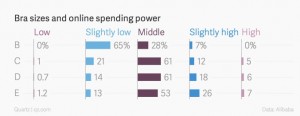Yesterday I gave a talk about so-called ‘Big Data’ to a group of senior executives. At one stage I used the famous Walmart pop-tart discovery as an example of how organisations sometimes discover things they didn’t know by mining their data. But now comes an equally intriguing data-mined discovery — from Alibaba:
Earlier this summer, a group of data crunchers looking at underwear sales at Alibaba came across a curious trend: women who bought larger bra sizes also tended to spend more (link in Chinese). Dividing intimate-apparel shoppers into four categories of spending power, analysts at the e-commerce giant found that 65% of women of cup size B fell into the “low” spend category, while those of a size C or higher mostly fit into the “middle” or higher group.
The explanation might be fairly straightforward: it could be that the data merely demonstrate that younger women have less spending power, for instance. But Alibaba is deep into this data-mining stuff. The report claims that last year the company set up a Big Data unit with 800 employees. It also quotes a Gartner factoid that currently less than 5% of ecommerce companies are using data analytics.

